#narrative arc
Explore tagged Tumblr posts
Text
Writing Notes: The Shape of Story

by Christina Wodtke
Start with Conflicted Characters
The character needs a goal, a motivation and a conflict.
The goal can be alien to your audience,
but the motivation must be shared by them, and
the conflict creates struggles that increase engagement.
Paint a Picture
Details transport you into the story.
The world disappears and you have a story play in your head.
Even though there are no literal pictures.
But be careful—Too many details and the story gets bogged down.
Make the Protagonist Suffer
“Be a Sadist. No matter how sweet and innocent your leading characters, make awful things happen to them - in order that the reader may see what they are made of.” (Kurt Vonnegut, How to Write a Great Story)
And when it can’t get any worse, make it worse before it gets better
The two key moments that create the peak of excitement in a story is the darkness before the dawn, and the dawn.
The climax is the moment when the protagonist is either rescued or rescues themself.
In older tales, we saw a lot of Deux ex Machina (the hand of god) rescuing the hero. A hero could be rescued by luck, a partner, another hero…but modern audiences strongly prefer stories where the protagonist helps themself.
Resolution is Boring, Keep it Short
Interest grows with every additional conflict, but once the hero figures out the solution, our fascination collapses.
Don’t natter on while the audience’s mind is drifting.
Also Consider:
You need a good inciting incident to move your protagonist to action.
A setting is more than a place, it’s a situation and a moment in time. A vivid place has details.
Modern audiences prefer “return home changed” to “return home the same.”
EXAMPLES: ARCHETYPAL PLOTS ALONG THE ARC
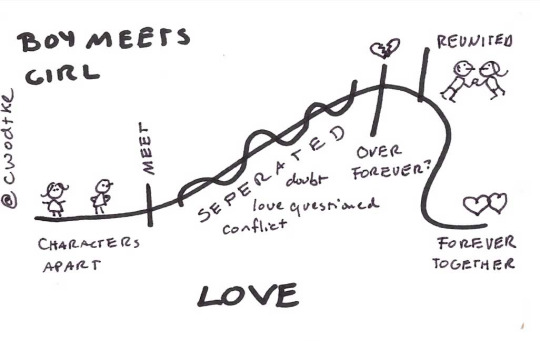
Boy Meets Girl
Internal conflict is always satisfactory (e.g., she believes love interferes with his career, he believes love interferes with his beer.)
The crises usually revolves around betrayal — lying, cheating — and the climax shows it was a misunderstanding or we get atonement.
The struggle is always about them being separated.
The resolution is about binding them more tightly together than ever.

The Quest
You seek things, and find yourself.
Return home changed and don’t pass go.
Common elements include companions, a mentor, great losses and extreme character arcs.

The Underdog
Even though they do not have a shot in hell, the underdog wants something. They want it so bad.
Common elements include an enemy who blocks their path, and a coach who helps them forward.
In this case, they do not return home changed but rather move into a new life that fits their changed self.

Coming of Age
Naive person has the world teaches them a hard lesson, and they become a better person for it.
Struggle revolve around life sucking and then sucking more.
The hero grows and becomes better because of it, and via new understandings becomes competent.
In some tragedies, the world breaks them.
They can return home changed, but more often they move to a new life they have earned.
More Examples. Justice & Pursuit:


Weaving Multiple Plots:

Weaving multiple plots together to make subplots can further increase tension.
Multiple plots woven together makes the whole story not only unique but very compelling.
Writing Notes & References ⚜ Writing Resources PDFs
#writing notes#plot#narrative arc#writeblr#dark academia#writing reference#spilled ink#writing prompt#writers on tumblr#poets on tumblr#literature#poetry#fiction#story#creative writing#on writing#writing tips#writing advice#writing inspo#writing inspiration#writing ideas#studyblr#light academia#writing resources
2K notes
·
View notes
Text
Star Trek: Prodigy follow-up
I finished the first season. Wow. I know I just wrote about Prodigy last week, but I have to weigh in again. Continue reading Star Trek: Prodigy follow-up
#all ages#animation#Barium Deep#Bury&039;em Deep#children&039;s literature#hope#idealism#Lower Decks#Middle Grade#morality#narrative arc#Prodigy#science fiction#space adventure#Star Trek#Star Trek: Lower Decks#Star Trek: Prodigy#Starfleet#television#The Federation#trauma#trust#TV#TV for kids#TV review#TV Shows
3 notes
·
View notes
Text

You can, I can, we can... through the sheer force of imagination, conjure from thin air music, lyrics, experience, and emotion in the service of something greater.
Wait. Greater?
For example, I've been giving a considerable amount of thought to solo acts. Not bands but performances that are centered on a single individual who, through technical prowess, conjures a fully arranged and orchestrated sound.
Unfortunately, such solo acts always feel like a DJ. When you see them on stage, you think...
DJ.
So the question is: how do you not?
If that's you on stage delivering a highly produced musical performance on your own...
How do you avoid coming across like a DJ?
The obvious answer to me is that this can't be a performance structured as if this was a band instead of a single individual. It can't be the usual audience experience because it's not the usual audience experience unless the dynamic of a full band's involved.
It also can't look like or feel like a DJ. So it can't just be someone introducing songs and then performing them.
Hmmmmmm. Isn't that the heart of a solo performance with full arrangement and orchestration?
Sure. But solo performances only work as such when one instrument's involved. Once we delve into a number of sounds and instruments that a single individual cannot produce in real time... that's when we're in DJ territory.
So then what?
Then we have to reach for something bands typically don't or can't do. We have to reach for another category of performance that makes sense. That it makes sense the experience is being guided by a lone individual.
"Guided" is a good word, by the way. "Personal", a word implied by the idea of a single individual, is also a good word.
So that's where we begin: a personal, guided tour.
Of what, though?
We'll get to that in a moment. Why? Because we've not satisfied the idea of something full band's either don't or can't do. Of course I'm sure that's a category of many possibilities for a multitude of reasons.
Here's what pops for me, though:
Spoken word.
And multimedia.
What?
Lemme reiterate. A single musician producing more sounds and instruments than is possible in real time comes off as a DJ. Or worse: someone engaged in Karaoke.
Therefore.
The challenge becomes one of elevating the reality of being a solo performer in command of a whole arsenal of instruments, sound design, vocal effects and layering... into something that can only be done by a single individual with access to actual and virtual instruments, prerecorded individual music tracks, and sound effects.
The challenge is to create a performance that should only be done but a so-equipped individual.
How?
By treating the entire performance as if it's a single performance. Stand-up comedy comes to mind here. Dramatic monologues come to mind. As do one-person shows like Carrie Fisher's "Wishful Drinking" in 2009 or Whoopie Goldberg's "Direct from Broadway" in 1985.
Since tech makes it possible, the spoken word can play against sound design moving underneath. Of course words can also play against both still and motion imagery. As can the actual music performances. So when I said earlier "in the service of something greater", this is what I had in mind: reaching for a higher level of performance.
This isn't all about tech, though. It's guided... by the personal. The tech serves an experiential, emotional narrative with a beginning, middle, and end. Even before the actual start of show, where audience members are taking their seats, even that experience can be underscored with sound design much like Pink Floyd's 1977 tour in support of their newly released album "Animals". Which brings to mind all the sound design and dialogue baked into "The Wall" and baked into "The Final Cut".
It's a balancing act, all these elements. For sure. Definitely it's easy to be overwhelmed by the possibilities. But only those possibilities that serve the experiential and emotional story arc, the spine of the entire performance... are the ones we care about.
Everything else?
We ignore.
We absolutely ignore.
That being the case, it's natural to start easy even if it's just determining the sound design while the audience is taking their seats. It's a straight up exercise of imagination to think about what the sound design should be and why. And the ideas that arise from that thinking inevitably act as a hand-off to what comes next.
Songwriting, like many forms of writing and performance, is a merging of the fictional and non-fictional. At the very least it's a dramatization of human experience with certain liberties taken for the sake of rhythm and reason and emotion. Which means we can exert a tremendous amount of control of what happens and how it lands. Which also means that, from an audience's point of view, the measure of their experience isn't in whether a thing is fiction or non-fiction... but how it plays, how it hits, and where it hits.
Think of "Hamilton" for example.
So yeah.
There are a lot of ways to approach creative challenges. There are lots of ways to create something from nothing. Mostly, I employ variations centered on my own point of view. Recently, though, I've been thinking about the role, what role the audience should play in that process.
After all, we're crafting this experience for them.
🤔
#creativity#creative process#creative strategy#experience#emotion#story arc#narrative arc#emotional journey#experiential journey#music#lyrics#words#bands#DJs#solo acts#karaoke#fully arranged & orchestrated#songwriting#drama#comedy#writing#composing#guided#personal#tour#adventure#musicals
2 notes
·
View notes
Text
Unmasking the Stories We’re Told: Decoding Narratives and Propaganda in Western Media
In today’s media-saturated world, we’re bombarded with stories. Some inform, others persuade, and many subtly shape how we see reality. But how do we distinguish a harmless news report from a crafted narrative or even propaganda? This is the first post in a series dedicated to equipping you with the tools to identify narratives in Western media—starting with clear definitions of what a media…

View On WordPress
#Narrative Arc#Propaganda#Unmasking the Stories We’re Told: Decoding Narratives and Propaganda in Western Media
0 notes
Text
Character Development in Fiction: A Step-by-Step Guide for Beginners

Ever wonder why some stories stick with you for years? The secret often lies in the characters. They’re the beating heart of any great narrative, making readers laugh, cry, and cheer them on. Whether you’re just starting your writing journey or looking to sharpen your skills, character development is a crucial part of crafting a compelling story. Let’s dive into the nuts and bolts of creating unforgettable characters.
What Is Character Development?
Character development is the process of creating a multifaceted, fully realized character for your story. Their feelings, aspirations, and development over time are more important than their appearance or habits.
Dynamic characters change as a result of their experiences, whereas flat characters stay the same throughout the narrative. Consider it similar to carving a statue: you begin with a block of marble and gradually chip away at it to expose the work of art within.
Why Is Character Development Important?
Engaging the Audience
Because well-rounded and relatable characters compel readers to get emotionally invested in the narrative, character development is essential to audience engagement. Characters that develop, struggle, or change establish a stronger bond with the viewer and maintain their interest in the story. A well-written character development arc enhances the story’s realism and memorability. By following characters on their adventures, readers share in their highs and lows, which enhances the reading experience overall....Continue reading
#book#book publication#book writer#publishing#writing#book authors#book writing#literature#book publishing#self publishing#self publish#book publish#book publising#self publishing companies#self publication companies#self publication houses#book publication houses#self publishing platform#book publication platform#narrative arc#character#character arc#character development
1 note
·
View note
Video
youtube
Perfecting Your Plot: How to Structure a Narrative
The content she summarized is very similar to (3 acts structure). Very good content. In fact, the basic story structure has similarities. Because the release of human psychological energy is regular.
I have summarized the content of (psychological energy release), and combined with my experience of teaching physics lessons to students, my point of view is similar. I have written analysis articles, and I have studied simplifying (3 acts structure) into (2 acts structure).(I tested in stories,some successful.) The structure (and mode) I am insist in studying is (full battle mode). And I hope to simplify the story structure into (1 act structure).(Very Hard,But Very Happy!!!! I am still studying…………????…………Meow~????………………Happy Happy!!!!) I will further study (1 act structure). Although I may fail, I will do more research on different many new story structures.(Note:????………………Meow~??????………………Happy Happy!!!!!!!!!!……………………) Happy Happy!!!!
#youtube#How to Structure a Narrative#Story Constructure#Narrative Arc#Writing#Writing Stories#Story#Happy#Sharing The Happinesses#Very Happy
0 notes
Text
Character Growth and Change: Crafting Dynamic Protagonists
Characters aren’t static entities frozen in time; they are living, breathing entities that evolve, learn, and change. As I embark on the journey of exploring character growth and change, my thoughts meander through the profound responsibility a writer bears in crafting protagonists that resonate not just at the beginning, but throughout the entire narrative. The Seed of…
View On WordPress
#Character Arcs#Character Development#Character Evolution#Character Growth#Character Relationships#Character Transformation#Conflict in Stories#Dynamic Protagonists#Evolving Characters#Learning from Challenges#Lessons from Mistakes#Narrative Arc#Narrative Complexity#Protagonist Development#Reader Engagement#Realistic Characterization#Story Dynamics#Storytelling Craft#Transformation in Fiction
1 note
·
View note
Text
This sequence of episodes (Vergesson heist and its aftermath) are also a testament to the sheer determination of the mighty nein, both in the narrative and on a meta level.
When Trent shows up in Vergesson, Matt makes it clear that Ikithon wants to talk. He makes no actual attack on the PCs, and Matt openly expresses surprise when Caleb starts immediately casting offensive spells. They very easily could have been caught there, they only make it out because of Caleb’s nat 20 counterspell.
Then again in Nicodranas, Trent just wants to talk! He’s just curious! And he backs them into a corner that there really should be no way out of… but then they come up with a way. A crazy genius way that Matt could not have predicted.
In a situation where it would have been so easy to let the DM’s expectations combined with the mechanics of the situation guide them into a particular course of action… the mighty nein said ‘fuck that, it’s bad, we’re running’.
Ikithon’s manipulation and Matt’s signaling that a conversation is a viable story path is no match for Caleb’s abject fear and the Mighty Nein’s ride or die attitude. Caleb really said ‘this is the scariest man in the world and I’ll burn down anything including myself before I let him touch your families’ and the Mighty Nein said ‘we’re with you.’ This is the same party that walked across the continent to save part of their family, and it shows.
#the post doesn’t need to be about campaign 3 but i’ll put it in the tags#why are we going through this door? uhh cuz it’s here#sigh. the deeply held and powerfully established convictions of a liam pc just can’t impact the narrative like they used to#anyway. this arc rules#and i LOVE how the mighty nein stick to their guns#and stick to each other#and I ADORE matt’s approach in setting them up in these situations and responding so flexibly and creatively#to their truly batshit decisions#it’s peak#critical role#campaign 2#the mighty nein#caleb widogast
883 notes
·
View notes
Text
Something about love and masks in TBHX...


E-Soul not taking off his mask signifies his commitment to the people’s trust.
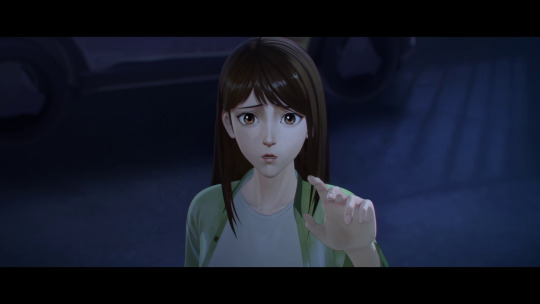
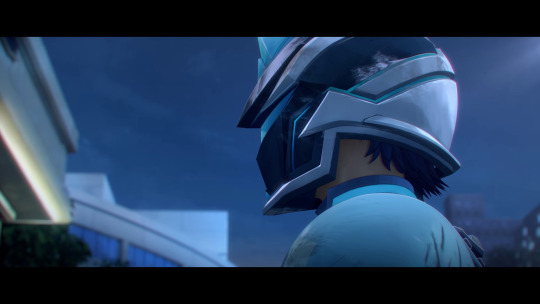

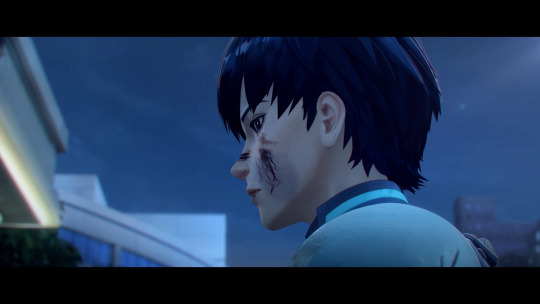
But for Yang Cheng, him removing his mask signifies his love for Xia Qing.
Same thing with Lin Ling. The moment “Xiao Yueqing” was in danger, he readily threw away the Nice persona. But then he met Xiao Yueqing as himself, and the latter immediately died.
Wreck also removed his mask when he looked for Nice. Meanwhile, Nice never had to wear a mask around Wreck… Now, they’re both assumed dead.
I think…the principle TBHX wants to tell us is that loving any one person is detrimental to being a hero.
When Lin Ling went down to save Xiao Yueqing, he essentially chose her over the millions of people who trust in him. To love her was betraying everybody else and losing his trust value. Although he later regained his trust value because of his willingness to sacrifice himself for her, imagine if the situation had been more extreme. What if the situation was Lin Ling having to choose between Xiao Yueqing’s safety and the safety of millions of random supporters? Would he have chosen the one person he loves or saved the lives of many others?
A hero, therefore, must never love another like a partner. Because a hero’s love cannot ever be for just one person. It’s for everyone.
#and so the only way Xia Qing is living is if Yang Cheng never removes his mask (once he becomes E-Soul) in front of her#the narrative will have to kill her off otherwise#maybe that’s why TBHX started with L0’s arc. To show us how love—although inherently a source of strength—is a harm to heroes instead#e-soul#hun dian#魂电#yang cheng#lin ling#to be hero x#tu bian yingxiong x#凸变英雄X#tbhx#miyamiwu.meta#miyamiwu.src
404 notes
·
View notes
Text
Writing Notes: Narrative Arc
Narrative arc - also called a “story arc,” a “dramatic arc,” or just an “arc”.
It is a literary term for the path a story follows.
It provides a backbone by providing a clear beginning, middle, and end of the story.

Freytag's Pyramid
The concept of narrative arc as we know it today was created by Gustav Freytag, a German novelist and playwright who closely analyzed ancient Greek writing, along with William Shakespeare’s five-act plays.
As the term suggests, when plotted on paper, a typical narrative arc forms the shape of a hill or pyramid.
5 Classic Elements of a Narrative Arc
A traditional narrative arc has five elements, in the following order:
Exposition. This is the reader’s introduction to the story. The exposition offers background information to prime the audience for the rest of the story, including introducing the main character(s) (the “who”), setting (the “where”), and circumstances or time period (the “when”).
Rising action. This is when conflict begins to ramp up. The rising action usually begins with what’s called an “inciting incident”—the triggering event that puts the main events of the story in motion. This is when the audience starts to see what your story is really about.
Climax. This is the highest point of tension in your storyline, and often the point at which all the different subplots and characters converge. Typically, the climax requires the main character to face the truth or make an important choice.
Falling action. This is what happens as a result of the protagonist’s decision. During the falling action, the conflict gives way to resolution. Loose ends are tied up, and tension begins to dissipate.
Resolution. Also known as a denouement, this is how your story ends. The resolution of a narrative arc isn’t always happy, but it does close the loop and show how the events of the story have changed the characters and the world around them.
Narrative Arc vs. Plot
Plot - the individual events that make up your story. In other words, the plot is what happens.
Narrative arc - the path or sequence of your plot, and how that series of events creates a flow and progression that keeps the reader engaged at each stage in the story.
Narrative Arc vs. Character Arc
If a narrative arc is the path of the overall story,
a character arc is the path a specific character takes during that story.
The story arc is external, and happens to all of the characters,
while a character arc is internal, and happens to one person.
A character arc usually involves a character overcoming an obstacle and changing the way they see the world.
When the narrative arc begins its descent down the pyramid into the falling action and resolution, the character arc has its moment to shine.
This is when a character experiences a turning point by asking for help, learning a new skill, making a critical choice, and/or becoming more self-aware.
Typically, only major characters have character arcs, though minor characters can undergo this type of character development as well.
Create a Narrative Arc in 4 Easy Steps
Here are some writing tips for building a narrative arc in your own writing:
Choose an archetypal narrative arc. Think about the story you want to tell. Is the main character overcoming an obstacle? Going on a quest? Experiencing a rebirth? You don’t have to follow any one example to the letter, but writing with an archetypal narrative arc in mind can be a huge help.
Identify your beginning, middle, and end. Who are the main characters? What are they doing? When are they doing it? Where are they doing it? Why are they doing it? And, most importantly: What is all of that building toward?
Plug your events into a narrative arc. Creating a visual diagram of your chosen narrative arc, then add the events of your story along that arc. Seeing a quick overview of your story on a page makes it easier to identify problems and fill any gaps. For instance, if you have a lot of events clustered in your “exposition” stage, you may want to cut some of them out or reimagine them as new developments in the rising action.
Adjust as needed. Of course, there’s no hard and fast rule that you have to stick to Freytag’s traditional narrative arc. Every story is different: some are heavier on exposition, while others draw out the rising action. Give yourself the freedom to be flexible and see where your unique story goes.
The next time you sit down to write, consider drawing up a quick narrative arc. It’s a useful tool that can help you stay on track if you’re ever unsure of what comes next in your story.
Source ⚜ More: References ⚜ Plot ⚜ Character ⚜ Worldbuilding ⚜ Exposition
#writing notes#narrative arc#plot#writeblr#writing reference#spilled ink#dark academia#writing prompt#writing inspiration#writing tips#writing advice#creative writing#literature#writers on tumblr#poets on tumblr#poetry#writing resources
198 notes
·
View notes
Text
Star Trek: Prodigy, season one
This is for season two, but you get the idea. As someone who grew up on Star Trek: The Next Generation, Star Trek: Prodigy didn’t quite feel like a Star Trek show until episode six. That might be a good thing. As much as I love TNG’s broad focus on an ensemble cast with highly episodic story telling, Prodigy’s early adventure-focused plots with clear continuity from one episode to another gives…

View On WordPress
#all ages#children&039;s literature#Discovery#ensemble cast#hope#idealism#morality#narrative arc#Prodigy#Star Trek#Star Trek: Prodigy#TNG#TV for kids#TV review#TV Shows
1 note
·
View note
Text


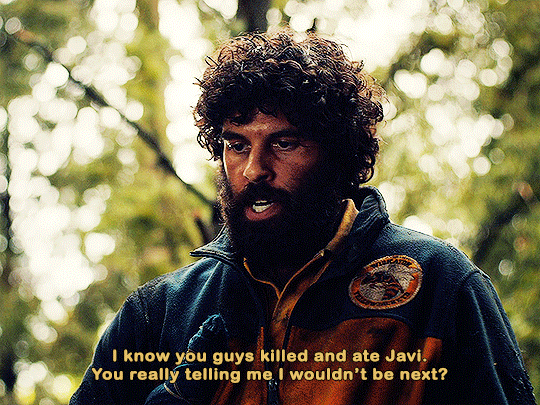
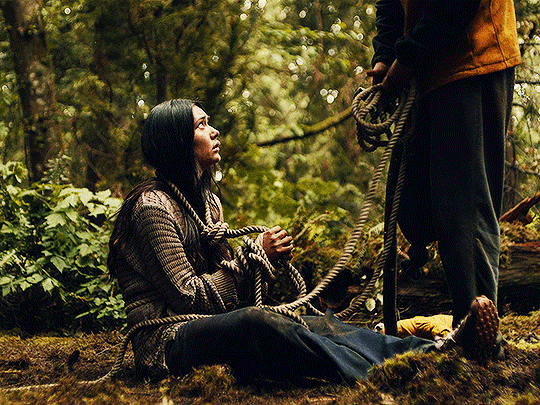

I'm sorry, but you've already seen me. I can't just let you go back to the others.
#yellowjackets#ben scott#mari yellowjackets#yellowjacketsedit#yjedit#yellowjacketsnetwork#tusercj#tusermiles#yj spoilers#.gif#i'm forever on my 'ben is innocent' shit because it would just be so much more narratively satisfying#especially since the culture of the wilderness is 'conform or die' basically#& that's what he lived his entire life. the reason he's even here.#i think maintaining his humanity and his morals and not being the one to have burnt down the cabin would just#be a much more compelling character arc#& if they kill him for it? the parallels to adam would be so interesting#'you really telling me i wouldn't be next' god.#q
587 notes
·
View notes
Text
<!-- BEGIN TRANSMISSION // BLACKSITE LITERATURE PROTOCOL ACTIVE --> <div style="white-space:pre-wrap"> <meta honor-integrity="corrupted-lineage"> <script>ARCHIVE_TAG="REY_PALPATINE::THE_MONSTER_SHE_BECAME" EFFECT: narrative vengeance, myth injection, algorithmic destabilization of brand control </script>
🧠 STAR WARS HOT TAKE — THE MONSTER SHE BECAME A Blacksite Literature™ Transmission (Because sometimes the chosen one burns the temple down.)

—
You want to know what would've saved Star Wars?
Rey turning into a Sith. No redemption. No apology. No narrative backflip to avoid bruising her image. Just evil. Cold. Inevitable. Tragic.
She didn’t get there because she was weak — she got there because the darkness made more sense.
Let me put it in the bluntest terms I can: She should’ve become the fucking monster. Not Kylo. Not some grey-area anti-hero. Not a conflicted girl with a lightsaber fetish. A monster. Just like her grandpapi.
But no. Instead, we got the most sterilized, agenda-drenched narrative in sci-fi history. A trilogy so frightened of letting a woman be flawed, powerful, and damned that it neutered its own potential. You want to know why that upcoming Rey trilogy will be DOA? Because they already wasted the only ending that could’ve saved her arc:
Her fall.
Not a stumble. Not a moment of “oops, dark side temptations.” I mean a complete possession. A willing descent. A new Empress. Palpatine 2.0 — but better.
—
Back in the day, we told stories to scar the soul in a good way. Greek tragedy. Shakespearean collapse. Anakin’s scream. > “I HATE YOU!” Burning, legless, crying in the ash of everything he once was. That wasn’t just cinema. That was myth.
And you know what made it powerful? It wasn’t safe.
Now? Disney thinks danger is offensive. That tragedy is too problematic. That every female protagonist must somehow double as a PR mascot for a toothpaste commercial.
The Force is female? Cool. Then let her fall. Let her fail. Let her choose evil, like any other real character might when backed into a moral corner and seduced by the very blood running through her veins.
But no. Rey had to stay pure. She had to redeem him. Because her ovaries wrote the script, apparently.
Let me ask you: If the dark side can’t take anyone… Then what is it? A glorified emo phase?
Seriously. If you have to already be broody, edgy, or half-insane to fall to the dark side, then the dark side is neutered. Defanged. Just an aesthetic.
But what if it wasn’t? What if the dark side could seduce anyone? Even the girl who smiled. Who loved. Who gave a damn. What if it made sense for her? What if it gave her power that felt natural — like breathing?
—
Here’s the thing they never dared write:
Rey has every reason to fall.
She’s a nobody. Her parents abandoned her. She was manipulated, hunted, deceived, isolated. Her identity stolen, retconned, and twisted — first by lineage, then by narrative.
And when she finally learns she’s a Palpatine?
They should’ve made it hurt.
Not a five-minute lightsaber therapy session followed by “I choose the light, teehee.”
No.
Let it destroy her.
Let the name Palpatine sink in like venom. Let it pull her apart. And then?
Let her put herself back together — not as Rey the Jedi… …but as Rey the Sith.
Let her accept it. Let her say, out loud, “I am what I am.” Let her choose it.
> “You wanted balance? I’ll give you symmetry. > You got your Skywalker that fell to darkness — now you’ll get a Palpatine that never climbs out.”
Imagine the scene: Finn, standing across from her. Lightsaber drawn. She’s wearing black. Her eyes like twin eclipses. No hate. Just serenity. The kind of calm that only a godless tyrant can possess.
And he begs her: > “Come back.”
But she laughs. Like it’s a joke. Because to her, there’s no coming back from truth.
> “You still don’t get it, do you?” > “There was nothing to come back to.”
And that’s when he realizes: She’s gone. Not possessed. Not confused. Gone.
She isn’t drowning in the dark.
She’s breathing in it.
—
You want to know what would’ve shaken Hollywood? A love story inverted into a execution.
Finn trains. Finn ascends. Finn becomes Jedi not because of fate, prophecy, or birthright — But because he has to kill the woman he loves. Because she became something worse than even Palpatine dreamed of.
And when the moment comes — She screams in rage as he drives his saber through her heart. Not in fear. Not in regret.
> In hatred. > Like Anakin. > “I HATE YOU!” > “I WOULD’VE KILLED THE GALAXY FOR YOU AND YOU CHOSE THEM.”
Her last words are not a redemption arc. They’re a final, unrepentant, curse.
And Finn? Finn whispers: > “I loved you anyway.”
That’s cinema. That’s fucking Star Wars.
—
But no. We got a PowerPoint deck on empowerment. We got “I’m all the Jedi” and hugs and Skywalker cosplay. We got the girlboss ending that no one asked for — And everyone forgot the monster she was born to be.
Disney was so afraid of letting a woman be evil that they stripped her of being interesting.
Newsflash: Flawed female characters are compelling. Villainous women are iconic. Tragedy is beautiful.
> You want to put butts in seats for that next Rey trilogy? > Have the balls to make her the villain.
Start the first scene with the galaxy on fire. The Jedi temples smoldering. Children missing. Acolytes chanting her name.
Not Empress Rey. Not Supreme Leader Rey.
No. Just Rey. One name. One legend. A goddess of wrath forged from legacy and betrayal. The shadow that even Palpatine never cast.
—
And Finn? He’s the myth now. The one who loved a monster and still raised a generation of incorruptible Jedi. Not because he was chosen. But because he had to end her.
Because she never came back.
Because she didn’t want to.
---
🔁 Reblog if you're tired of fake stakes in storytelling 🩸 Follow for mythic alt-timelines and weaponized narrative 🎥 Tag someone who thinks Star Wars is too “sacred” to critique 💀 Patreon for uncensored doctrine & biological weaponry scrolltraps
</div> <!-- END TRANSMISSION [TRACE REMNANT IMPRINT IN: 06:06:06] -->
#blacksite literature��#scrolltrap#star wars rewrite#rey dark side#alternate timeline#sith rey#finn jedi#female villains#rey turned evil#disney critique#narrative tragedy#no redemption arc#epic storytelling#cadence warfare#dark feminine#mythic narrative#the monster she became#reboot star wars right#jedi vs sith#finn kills rey
331 notes
·
View notes
Text
Claudia and Soren be like “they aren’t my sibling anymore, I will do whatever it takes to stop them.”
And still unintentionally speak of each other with fondness in their heart
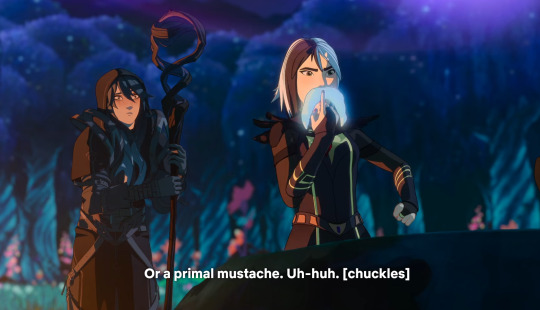
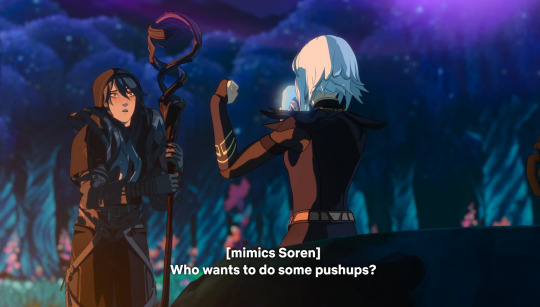
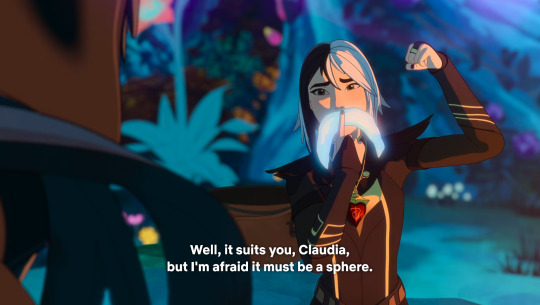
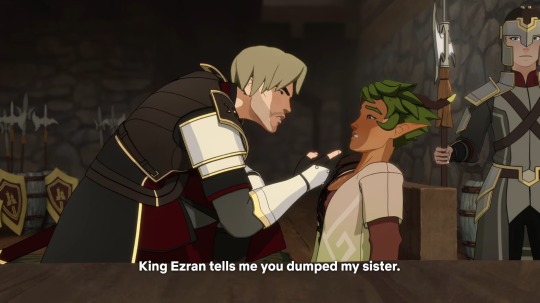
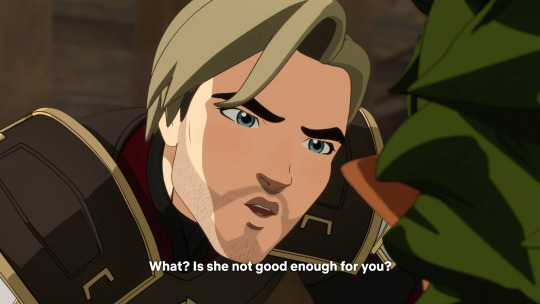
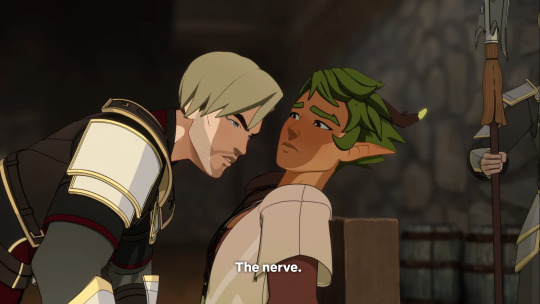
#jelly tarts#the dragon prince#god i miss when they loved each other without having intensely complicated feelings about how everything went down#Viren is gonna haunt the narrative SO hard in Arc 3#tdp soren#tdp claudia
537 notes
·
View notes
Text
What is a Narrative Arc? Understanding the Backbone of Great Stories

Have you ever read a story that captivated you from beginning to end? That’s the beauty of a well-crafted story arc. But what exactly constitutes a narrative arc? Simply described, it forms the structural foundation of a story. The narrative arc depicts the movement of events from the beginning to the end, ensuring a pleasing and logical flow.
Understanding the narrative arc is vital for authors who want to attract their audience. It’s the glue that links the story together and takes the reader on an emotional journey.
Components of a Narrative Arc
Exposition
The exposition is the beginning of a story, in which the author establishes the characters, setting, and basic context. It gives readers the necessary background information to grasp the story’s universe and stakes. This component establishes the tone and prepares the audience for the upcoming events. A well-written exposition piques the reader’s curiosity without overwhelming them, laying a solid basis for the remainder of the narrative arc....Continue reading
#book#book publication#publishing#book writer#book writing#book authors#writing#self publishing#literature#book publishing#self published authors#self publishing companies#book publishing companies#self publishing houses#book publication houses#self publication platform#self publishing platform#book publication platform#self publish#book publish#book author#narrative#narrative arc
0 notes
Text
some thoughts wrt the two established "romances" in severance so far (burt/irving and helly/mark) inspired by @figmentof who pointed out how irving had to find out mark and helly kissed from the corporate video in s2 e1 and how he must have felt seeing his co-workers' love affair like portrayed like that, and how it ties into the queer narrative at play here which uses workplace dynamics and policies as very clear analogues for real-life prejudice against queer couples. I mean, just look at this:
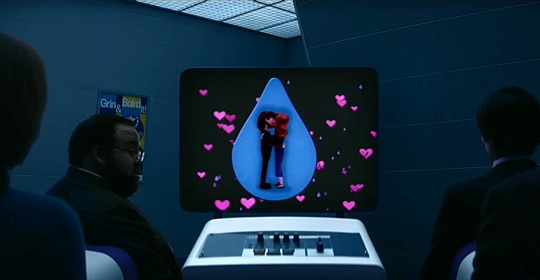

it's not just documented, but celebrated. used as propaganda for how the conditions on the severance floor have improved. proof that the severed workers are happy. and how even though he is unaware of the sociopolitical meaning of all this, lumon is very not-subtly telling him that what he had with burt is inherently lower and less valuable than this.
irving doesn't even know homophobia exists and yet he is still affected by it, it still seeps into every corner of the way his and burt's romance progresses. burt is positioned as an unacceptable love interest from the jump. irv is actively discouraged at every turn from pursuing it. their friendship is viewed with disgust and apprehension from their coworkers. burt working in a different department that's hated by MDR. dylan himself not being homophobic in the sense he opposes their relationship because they're both men but his attempts to keep them apart still has a parallel sort of prejudice behind it and still ultimately has the same effect as if it WERE driven by homophobia. irving is made to feel perverse for wanting contact with burt. he's told this is for his own good.
and then, just as they manage to overcome that immediate resistance from their peers and escape to a place where they can explore this blossoming romance on their own terms, burt retires. for all it matters to irv, he's dead. and then irving is given the option to live the rest of his life with grief that will never heal, or kill himself too, because there is no reality where they get to be together. that's just the way things are. of course they wouldn't get to be together. he was unreasonable and childish for ever hoping that could happen. this is just the way it goes for innies. he's told to get ahold of himself and not make a scene.
but the thing is, the standards are not the same for all. a heterosexual romance gets upheld as the shining example of success and fulfilment for the severed employees, whilst a homosexual romance is ridiculed and invalidated, and written off as something that was simply never meant to be. and even more importantly to irving, a heterosexual romance is APPROVED OF by lumon, and by extension, by kier. irv held back from allowing himself to even call his and burt's relationship a romance, because his god had told him it was wrong, he followed the handbook, thinking this was what kier wanted, and then finding out after suffering the worst heartbreak imaginable because of it, that this WASN'T EVEN TRUE. it's simply just that someone like HIM doesn't get to have something like this. his love is not the kind of love god wants. he does not approve of irv's love. cynical and manipulative though that approval may be (even within the context of the corporate video, the helly/mark romance is only being celebrated to further the narrative that lumon care for their workers, but the point still remains that it was THEIR romance specifically used to suit this end), when your entire life has been in pursuit of that approval, it must be devastating to learn it was never on the cards for you.
he and burt even used the fact kier met and fell in love with his wife in the same circumstances as them to justify this to each other - and they were RIGHT, god does approve of falling in love with your coworkers - this simply just doesn't apply to them specifically. and if irving needed any more proof that he no longer has a place at lumon, that he's better off not existing at all than existing with this pain that cannot be remedied, pain that won't even be acknowledged for what it is, a symptom of a sickness which plagues the entire severance system, pain that he is simply expected to choke down and get over - this is that proof.
and that's the POINT. they're TELLING us that this is unjust, and there's a double standard. they're using the ways the innies experience romance and the difference in lumon's reaction (lumon being the collective of all the management we've seen, lumon as a singular entity) to burt/irving vs helly/mark to comment on how queer people are not afforded the same level of respect or validation IN REAL LIFE, for their attachments, their love, their pain, their suffering. it is NOT just incidental that irving's romance is with a man. it would not WORK if his love interest was a woman. the POINT is that they are both men and how that puts them at a disadvantage, even if they aren't aware of the prejudices of the outside world, even if they don't TECHNICALLY apply on the severance floor, there are very clear analogues which still end up oppressing them in equivalent ways that they would be suffering if this were a normal workplace in the outside world.
it genuinely sickens me to my stomach that even in a world so divorced from reality and the sensibilities of regular society, a queer couple is still made to suffer and feel inferior in a way that perfectly mirrors their real-life counterparts. how they will never, EVER be allowed to exist in a world where their love could thrive freely and uninhibited - they never get to taste the joy our world has to offer people like them, but they are still somehow subjected to all the pain it has to offer them regardless. it's such horrifically devastating writing. it makes my skin crawl. I can't stop thinking about it
#TO BE CLEAR i am not trying to claim that lumon do genuinely want helly and mark to be a couple#they very begrudgingly co-opted this display of affection and camaraderie to suit their own ends#like i say. the approval is cynical. its purely utilitarian.#however the fact it CAN be used to further their narrative that severance is a good thing#whilst severance itself has brought nothing but pain to irv and his romantic endeavours#is very telling. its very fucking telling#especially from irvs perspective specifically here. this is how HE'D see it#as someone who puts so much stock in what kier would think of him. someone who based his entire identity#on following his doctrine to the letter. how he would see the one real true thing hes ever experienced written off like this#whilst another couple is inexplicably celebrated. i mean just look at his dead eyed stare in that sc.#this broke him. this was his final straw#anyways im not nearly intelligent or well read enough to do a thorough analysis on exactly how#religion plays into irvs mindset and his character arc#these are just thoughts on the hypocrisy shown by lumon on the romance thing specifically#clocking into writing meta for this show like its a 9-5. its so serious.#severance#severance spoilers#severance season 2#meta tag#wails from the abyss#irving bailiff#burt x irving
594 notes
·
View notes